Armenian Apostolic Church
The Armenian Apostolic Church (Armenian: Հայ Առաքելական Եկեղեցի, romanized: Hay Aṙak'elakan Yekeghetsi)[note 1] is the national church of the Armenian people. Part of Oriental Orthodoxy, it is one of the most ancient Christian institutions.[5] The Kingdom of Armenia was the first state to adopt Christianity as its official religion under the rule of King Tiridates III in the early 4th century.[6][7] According to tradition, the church originated in the missions of Apostles Bartholomew and Thaddeus of Edessa in the 1st century.
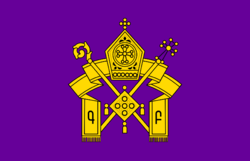 Armenian Apostolic Church | |
|---|---|
| Armenian: Հայ Առաքելական Եկեղեցի | |
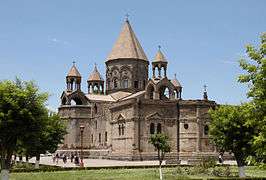 Etchmiadzin Cathedral, the mother church of the Armenian Apostolic Church | |
| Classification | Eastern Christian |
| Orientation | Oriental Orthodox |
| Scripture | Septuagint, New Testament |
| Theology | Miaphysitism |
| Polity | Episcopal |
| Governance | Holy See of Cilicia |
| Head | Catholicos of All Armenians Karekin II |
| Associations | World Council of Churches[1] |
| Region | Armenia, Armenian diaspora |
| Language | Classical Armenian |
| Liturgy | Armenian Rite |
| Headquarters | Etchmiadzin Cathedral, Mother See of Holy Etchmiadzin, Vagharshapat, Armenia |
| Founder | St. Gregory the Illuminator Apostles Bartholomew and Thaddeus of Edessa |
| Origin | c. 1st century Kingdom of Armenia |
| Separated from | Patriarchate of Constantinople in the Second Council of Dvin (554)[2] |
| Members | 9,000,000 (self-reported)[3] |
| Other name(s) | Armenian Church Armenian Orthodox Church |
| Official website | www |

It is sometimes referred to as the Armenian Orthodox Church or Gregorian Church. The latter is not preferred by the church itself, as it views the Apostles Bartholomew and Thaddeus as its founders, and St. Gregory the Illuminator as merely the first official governor of the church. It is also known simply as the Armenian Church.
History
Origins
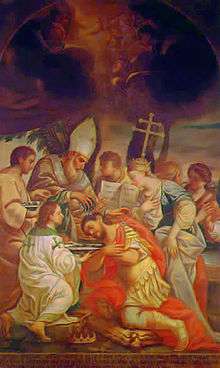
The Armenian Orthodox Church believes in apostolic succession through the apostles Bartholomew and Thaddeus of Edessa.[8][9][10] According to tradition, the latter of the two apostles is said to have cured Abgar V of Edessa of leprosy with the Image of Edessa, leading to his conversion in 30 AD. Thaddaeus was then commissioned by Abgar to proselytize throughout Armenia, where he converted the king Sanatruk's daughter, who was eventually martyred alongside Thaddeus when Sanatruk later fell into apostasy. After this, Bartholomew came to Armenia, bringing a portrait of the Virgin Mary, which he placed in a nunnery he founded over a former temple of Anahit. Bartholomew then converted the sister of Sanatruk, who once again martyred a female relative and the apostle who converted her. Both apostles ordained native bishops before their execution, and some other Armenians had been ordained outside of Armenia by James the Just.[9][10] Scholars including Bart Ehrman, Han Drijvers, and W. Bauer dismiss the conversion of Abgar V[11] as fiction.
According to Eusebius and Tertullian, Armenian Christians were persecuted by kings Axidares, Khosrov I, and Tiridates III, the last of whom was converted to Christianity by Gregory the Illuminator.[8] Ancient Armenia's adoption of Christianity as a state religion (the first state to do so) has been referred to by Nina Garsoïan as "probably the most crucial step in its history."[12] This conversion distinguished it from its Iranian and Mazdean roots and protected it from further Parthian influence.[8][12] According to Mary Boyce, the acceptance of Christianity by the Arsacid-Armenian rulers was partly in defiance of the Sassanids.[13]
When King Tiridates III made Christianity the state religion of Armenia between 301 and 314, it was not an entirely new religion there. It had penetrated the country from at least the third century, and may have been present even earlier.[14]
Tiridates declared Gregory to be the first Catholicos of the Armenian Orthodox Church and sent him to Caesarea to be consecrated. Upon his return, Gregory tore down shrines to idols, built churches and monasteries, and ordained many priests and bishops. While meditating in the old capital city of Vagharshapat, Gregory had a vision of Christ descending to the earth and striking it with a hammer. From that spot arose a great Christian temple with a huge cross. He was convinced that God intended him to build the main Armenian church there. With the king's help he did so in accordance with his vision, renaming the city Etchmiadzin, which means "the place of the descent of the Only-Begotten".[15]
Initially, the Armenian Orthodox Church participated in the larger Christian world and its Catholicos was represented at the First Council of Nicea (325). St. Vrtanes I the third Catholicos of the Armenian Apostolic Church through (333–341 AD), sent a letter with specific questions to Macarius of Jerusalem who was the Greek Orthodox Bishop of Jerusalem from (312-335, or 336 AD) sent to Jerusalem by a delegation of Armenian priests on the occasion of the Encaenia, in dedication of the Church of the Holy Sepulcher in Jerusalem in September 335 AD. In Macarius's letter to the Armenians in 335 AD, it seeks to correct irregularities in the initiation rites of Baptism and the Eucharist currently in use in the Armenian Church by articulating present practices in Jerusalem. In so doing, it reveals the divergent forms being practiced in Armenia, which have strong echoes of old East Syriac Rite. Orthopraxy was conceived by Vrtanes and his Armenian colleagues in terms of liturgical performance in Jerusalem. In 353, King Papas (Pap) appointed Catholicos Husik without first sending him to Caesarea for commissioning before Rome had any plans for a universal Roman church.[16] Its Catholicos was still represented at the First Council of Constantinople (381).
Christianity was strengthened in Armenia in the 5th century by the translation of the Bible into the Armenian language by the native theologian, monk, and scholar, Saint Mesrop Mashtots. Before the 5th century, Armenians had a spoken language, but it was not written. Thus, the Bible and Liturgy were written in Greek or Syriac rather than Armenian. The Catholicos Sahak commissioned Mesrop to create the Armenian alphabet, which he completed in 406. Subsequently, the Bible and Liturgy were translated into Armenian and written in the new script. The translation of the Bible, along with works of history, literature and philosophy, caused a flowering of Armenian literature and a broader cultural renaissance.[17]
Although unable to attend the Council of Ephesus (431), Catholicos Isaac Parthiev sent a message agreeing with its decisions.[18] However, non doctrinal elements in the Council of Chalcedon caused certain problems to arise.
Independence
At the First Council of Dvin in 506 the synod of the Armenian, Georgian, and Caucasian Albanian bishops were assembled during the reign of Catholicos Babken I. The participation of the Catholicoi of Georgia and Albania were set to make clear the position of the churches concerning the Council of Chalcedon. The "Book of Epistles" mentions that 20 bishops, 14 laymen, and many nakharars (rulers of Armenia) participated in the council. The involvement in the council discussion of different levels of lay persons seemed to be a general rule in Armenia.
Almost a century later (609–610) the 3rd Council of Dvin was convened during the reign of Catholicos Abraham I of Aghbatank and Prince Smbat Bagratuni, with clergymen and laymen participating. The Georgian Church disagreed with the Armenian Church, having approved the christology of Chalcedon. This council was convened to clarify the relationship between the Armenian and Georgian churches. After the Council, Catholicos Abraham wrote an encyclical letter addressed to the people, blaming Kurion and his adherents for the schism. The Council never set up canons; it only deprived Georgians from taking Communion in the Armenian Church.[19][20] Despite this, the Albanian Church remained under the jurisdiction of the Armenian Church while in communion with the Georgian Church.
Miaphysitism versus monophysitism
Like all Oriental Orthodox Churches, the Armenian Church has been referred to as monophysite by both Roman Catholic and Eastern Orthodox theologians because it rejected the decisions of the Council of Chalcedon, which condemned the belief of one incarnate nature of Christ (monophysis). The Armenian Church officially severed ties with Rome and Constantinople in 554, during the Second Council of Dvin where the Chalcedonian dyophysite christological formula was rejected.
However, again like other Oriental Orthodox Churches,[21] the Armenian Orthodox Church argues that the identification as "monophysitism" is an incorrect description of its position.[22] It considers Monophysitism, as taught by Eutyches and condemned at Chalcedon, a heresy and only disagrees with the formula defined by the Council of Chalcedon.[22] The Armenian Church instead adheres to the doctrine defined by Cyril of Alexandria, considered as a saint by the Chalcedonian Churches as well, who described Christ as being of one incarnate nature, where both divine and human nature are united (miaphysis). To distinguish this from Eutychian and other versions of Monophysitism this position is called miaphysitism. Whereas the prefix "mono-" (< Greek μονο- < μόνος) means "single, alone, only",[23][24] thus emphasising the singular nature of Christ, "mia" (μία "one" FEM),[25] simply means "one" unemphatically, and allows for a compound nature.
In recent times, both Chalcedonian and non-Chalcedonian churches have developed a deeper understanding for each other's positions, recognizing their substantial agreement while maintaining their respective positions.
Structure and leadership
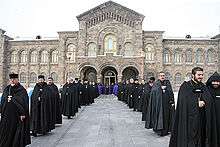
The Armenian Apostolic Church is the central religious authority for the Armenian Orthodox population in Armenia as well as for Armenian Orthodox communities worldwide.
It is headed by a Catholicos (the plural is Catholicoi). It is traditional in Eastern churches for the supreme head of the church to be named 'Patriarch', but in the Armenian Apostolic Church hierarchy, the position of the Catholicos is not higher than that of the Patriarch. The Armenian Apostolic Church presently has two catholicoi (Karekin II, Supreme Patriarch and Catholicos of All Armenians, and Aram I, Catholicos of the Great House of Cilicia), and two patriarchs, plus primates, archbishops and bishops, lower clergy and laity serving the Church.
Both clergy and laity are involved in the administrative structure of the Church. Led by Karekin II, the spiritual and administrative work of the Armenian Church is carried out in Armenia in the areas of religion, preparation of clergy, Christian education, construction of new churches, social services, and ecumenical activities.
The following sees have their own jurisdiction:
The Catholicosate of the Great House of Cilicia located in Antelias, Lebanon, is led by Catholicos Aram I and it has dioceses in the countries of the Middle East, in Europe and in North and South America.
The Armenian Patriarchate of Jerusalem which has jurisdiction over all of the Holy Lands and the Diocese of Jordan, is led by Patriarch Archbishop Nourhan Manougian.
The Armenian Patriarchate of Constantinople and All of Turkey, which has jurisdiction in the modern day Republic of Turkey, is led by Patriarch Archbishop Sahak II Mashalian.[26]
The three aforementioned historic hierarchical sees administer to the dioceses under their jurisdiction as they see fit, while there is only spiritual authority of the Catholicosate of All Armenians.
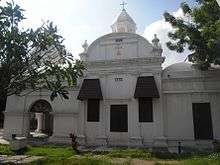
In addition to the responsibilities of overseeing their respective Dioceses, each hierarchical See, and the Mother See of Holy Etchmiadzin, has a Monastic Brotherhood.
Seminaries
The Mother See of Holy Etchmiadzin operates two seminaries, the Gevorkian Theological Seminary at the Mother See of Holy Etchmiadzin, and the Vaskenian Theological Academy at Lake Sevan. Over a 6-year course of simultaneous study, students receive both a bachelor's degree and a master's degree in Theology. The Great House of Cilicia operates one seminary, the Seminary of Antelias at Bikfaya, Lebanon. Upon graduation, students receive the equivalent of a high school diploma and pre-graduate theological study.
The Armenian Patriarchate of Jerusalem operates the St. Tarkmanchatz School (high school diploma) as well as the Theological Seminary of the Patriarchate. Graduates from the Theological Seminary can become ordained priests..
The Armenian Patriarchate of Constantinople had its own seminary, the Holy Cross Patriarchal Seminary, which was shut down by Turkish authorities in Turkey along with all other private schools of higher education.
St. Nersess Armenian Seminary in New Rochelle, NY also trains Armenian priests, awarding the Master of Divinity in Theology (through an affiliation with nearby OCA St. Vladimir's Seminary). St. Nersess also offers a Master of Arts in Armenian Christian Studies.[27]
Structure
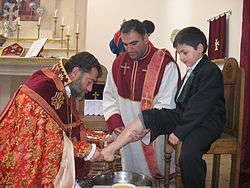
Regionally, each area of the world where the Armenian Church and faithful are located has dioceses, which are led by a primate from the Diocesan headquarters. Each diocese is made up of parishes and smaller communities.
The spiritual and administrative bodies representing the authority of the Armenian Church are the following:
The National Ecclesiastical Assembly is the supreme legislative body presided over by the Catholicos of All Armenians. The members of the National Ecclesiastical Assembly are elected by the individual Diocesan Assemblies. The National Ecclesiastical Assembly elects the Catholicos of All Armenians.
The Council of Bishops is an administrative-deliberative body presided over by the Catholicos of All Armenians. It makes suggestions on the dogmatic, religious, church, parish and canonical issues to be discussed as agenda items during the National Ecclesiastical Assembly.
The Supreme Spiritual Council is the highest executive body of the Armenian Church and is presided over by the Catholicos of All Armenians. The members of the Council can be elected by the National Ecclesiastical Assembly or appointed by the Catholicos of All Armenians. The Catholicos of All Armenians, Gevorg V. Soorenian established the Supreme Spiritual Council on January 1, 1924, to replace the Synod of Bishops.
The Diocesan Assembly is the highest legislative (canonical) body of each Diocese and is headed by the Primate of the Diocese. The Diocesan delegates (representatives of each parish community) elect the delegates to the National Ecclesiastical Assembly, the members of the Diocesan Council as well as discuss and decide on administrative issues within the Diocese such as committees, budgets, building, etc. In some Dioceses, the Diocesan Assembly elects the Primate of the Diocese.
The Diocesan Council is the highest executive power of a diocese, presided over by the Primate of the Diocese. It regulates the inner administrative activity of the Diocese under the direction of the Primate. The Diocesan Assembly elects members of the Diocesan Council.
The Monastic Brotherhood consists of the celibate clergy of the monastery who are led by an abbot. As of 2010, there were three brotherhoods in the Armenian Church – the brotherhood of the Mother See of Holy Etchmiadzin, the brotherhood of St. James at the Armenian Patriarchate of Jerusalem and the brotherhood of the See of Cilicia. Each Armenian celibate priest becomes a member of the brotherhood in which he has studied and ordained in or under the jurisdiction of which he has served. The brotherhood makes decisions concerning the inner affairs of the monastery. Each brotherhood elects two delegates who take part in the National Ecclesiastical Assembly.
The Parish Assembly is the general assembly of the community presided over by the spiritual pastor. The Parish Assembly elects or appoints the members of the Parish Council and the representatives or delegates to the Diocesan Assembly.
The Parish Council is the executive-administrative body of the community. It is presided over by the spiritual pastor of the community who takes up the inner administrative affairs of the parish and is engaged in the realization of its administrative and financial activities. Members of the parish council are elected or appointed at the parish assembly.
The Armenian Apostolic Church is one of a few apostolic churches in the world to have a democratic system; the people decide if they want to keep priests in their churches and may ask for different ones, as do some other ecclesiastical constitutions, such as Baptists and other Congregational churches.
Note that the Armenian Apostolic Church should not be confused, however, with the Armenian Catholic Church whose Patriarch-Catholicos (of the Armenian Catholic Rite) is Krikor Bedros XX Gabroyan, which is an Eastern Catholic church in communion with the Holy See in Rome.
Two Catholicosates
The Armenian Apostolic Church currently has two Sees, with the Catholicos of All Armenians residing in Etchmiadzin, Armenia, at the Mother See of Holy Etchmiadzin, having pre-eminent supremacy in all spiritual matters over the See of Cilicia, located in Antelias, Lebanon, which administers to the dioceses under its jurisdiction as they see fit. The two Sees are as follows:
Mother See of Holy Etchmiadzin
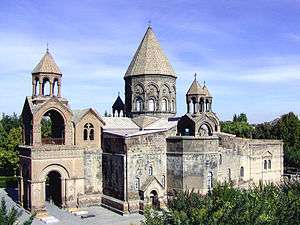
The Mother See of Holy Etchmiadzin (Armenian: Մայր Աթոռ Սուրբ Էջմիածին) is the spiritual and administrative headquarters of the worldwide Armenian Church, the center of the faith of the Armenian nation – the Mother Cathedral of the Armenian Church, and the Pontifical residence of Karekin II.
Preserving the past are the numerous museums, libraries and the Mother Cathedral itself, in which many historically and monetarily precious atems are contained. The Mother See is responsible for the preservation of artifacts, both those created by the Church and those given to the church as gifts over time.
Under the leadership and guidance of Karekin II, the Mother See administers social, cultural and educational programs for Armenia and the Diaspora.
The Mother Cathedral is the most recognised landmark of the Armenian Church. Built and consecrated by St. Gregory the Illuminator and St. Trdat the Great in AD 303, the Cathedral is located in the city of Vagharshapat, Armenia.
It is said that St. Gregory chose the location of the Cathedral in accordance with a vision. In his dream he saw "Miatsin", the Only Begotten Son of God, with glittering light on his face descending from the Heavens and with a golden hammer striking the ground where the Cathedral was to be located. Hence comes the name "Etchmiadzin", which translates literally to "the place" where Miatsin descended.
The Mother Cathedral is open every day; Divine Liturgy is celebrated every Sunday.
Great House of Cilicia

The Catholicosate of the Great House of Cilicia (Armenian: Կաթողիկոսութիւն Հայոց Մեծի Տանն Կիլիկիոյ) located in Antelias, Lebanon, is a regional See of the Armenian Apostolic Church and is an autonomous church with jurisdiction over certain segments of the Armenian diaspora.
As of 2012 Catholicos Aram I was the head and Catholicos of the Great House of Cilicia. The See has jurisdiction over prelacies in Lebanon, Syria, Cyprus, Greece, Iran, the Persian Gulf, the United States, Canada and Venezuela. In the United States, Canada, Syria, and Greece there are also Dioceses that are related to the Mother See of Holy Etchmiadzin, so there is duality of representation of the Armenian Apostolic churches in these countries.
The primacy of the Catholicosate of All Armenians (Mother See of Holy Etchmiadzin) has always been recognized by the Catholicosate of the Great House of Cilicia.
The rise of the Great House of Cilicia as an autocephalous church occurred after the fall of Ani and the Armenian Kingdom of the Bagradits in 1045. Masses of Armenians migrated to Cilicia and the Catholicosate was established there. The seat of the church (now known as the Catholicosate of the Great House of Cilicia) was first established in Sivas (AD 1058) moving to Tavbloor (1062), then to Dzamendav (1066), Dzovk (1116), Hromgla (1149), and finally to Sis (1293), then-capital of the Armenian Kingdom of Cilicia. Beginning in 1293 and continuing for more than six centuries, the city of Sis (modern-day Kozan, Adana, Turkey) was the center of the Catholicosate of the Great House of Cilicia.
After the fall of the Armenian Kingdom of Cilicia, in 1375, the Church continued in its leadership role in the Armenian community, and the Catholicos was recognized as Ethnarch (Head of Nation).
In 1441 Kirakos I Virapetsi of Armenia was elected Catholicos in Holy Etchmiadzin. At the same time the residing Catholicos in Sis, Gregory IX Mousabegian (1439–1446), remained as Catholicos of Cilicia. Since 1441, there have continued to be two Catholicosates in the Armenian Church, each having rights and privileges, and each with its own jurisdiction.
During the First World War and the 1915 Armenian Genocide, the Armenian population and the home of the Catholicosate at the Monastery of St. Sophia of Sis (which can be seen to dominate the town in early 20th-century photographs), was destroyed.[28] The last residing Catholicos in Sis was Sahag II of Cilicia (Catholicos from 1902 to 1939), who followed his Armenian flock into exile from Turkey.
Since 1930, the Catholicosate of the Great House of Cilicia has been headquartered in Antelias, Lebanon.
Reasons for the division
The division of the two Catholicosates stemmed from frequent relocations of Church headquarters due to political and military upheavals.
The division between the two sees intensified during the Soviet period and to some extent reflected the politics of the Cold War. The Armenian Revolutionary Federation (ARF) Dashnaktsutyun social democratic political party that had dominated the independent Armenia from 1918 to 1920 and was active in the diaspora, saw the Church and clergy, with its worldwide headquarters at the Mother See of Holy Etchmiadzin in the Soviet Republic of Armenia, as a captive Communist puppet, and accused its clergy in the US as unduly influenced by Communists, particularly as the clergy were reluctant to participate in nationalist events and memorials that could be perceived as anti-Soviet.[29] On December 24, 1933, a group of assassins attacked Eastern Diocese Archbishop Levon Tourian as he walked down the aisle of Holy Cross Armenian Church in the Washington Heights neighborhood of New York City during the Divine Liturgy, and killed him with a butcher's knife. Nine ARF members were later arrested, tried and convicted. The incident divided the Armenian community, as ARF sympathizers established congregations independent of the Mother See of Holy Etchmiadzin, declaring loyalty instead to the See based in Antelias in Lebanon. The division was formalized in 1956 when the Antelias (Cilician) See accepted to provide spiritual and religious guidance to those communities that the Mother See of Holy Etchmiadzin refused.[30]
The separation has become entrenched in the United States, with most large Armenian communities having two parish churches, one answering to each See, even though they are theologically indistinguishable. There have been numerous lay and clergy efforts at reunion, especially since the fall of the Soviet Union.
In 1995, Karekin II, Catholicos of Cilicia for the period 1983–1994, was elected Catholicos of All Armenians in the Mother See of Holy Etchmiadzin upon the death of Vazgen I, becoming Karekin I Catholicos of All Armenians, and serving as Supreme head of the church until 1999. He was unable to unite the two Catholicosates, however, despite his having headed both.
Two Patriarchates: Constantinople and Jerusalem
The Armenian Apostolic Church also has two Patriarchates of high authority both under the jurisdiction of the Catholicos of All Armenians. They are:
- Armenian Patriarchate of Jerusalem (Armenian: Առաքելական Աթոռ Սրբոց Յակովբեանց Յերուսաղեմ literally Apostolic Seat of St. James in Jerusalem) in the Armenian Quarter of Jerusalem headed since 2013 by the Patriarch of Jerusalem Archbishop Nourhan Manougian
- Armenian Patriarchate of Constantinople in Istanbul, Turkey (Armenian: Պատրիարքութիւն Հայոց Կոստանդնուպոլսոյ) headed since 1998 by Patriarch of Constantinople Archbishop Mesrob II Mutafyan. In July 2010, the spiritual council of Armenian Patriarchate of Constantinople approved the candidacy of Archbishop Aram Ateshyan to serve as Patriarchal Vicar of the Patriarchate. In July 2008, it was announced that Mesrob Mutafyan was suffering from Alzheimer's disease and had withdrawn from all his duties and from public life, but would be patriarch and archbishop all his life.
Eparchies (dioceses)
List of eparchies[31]
Armenia
- Aragatsotn eparchy
- Ararat Patriarchal eparchy
- Artik eparchy
- Gegharkunik eparchy
- Gougark eparchy
- Kotayk eparchy
- Shirak eparchy
- Syunik eparchy
- Tavush eparchy
- Vayots Dzor eparchy
- Artsakh eparchy (de facto independent Artsakh)
Diaspora
Old World
- Russia and New Nakhichevan eparchy (formerly Bessarabia and New Nakhichevan)
- Eparchy of the Russia South (formerly Astrakhan)
- Ukraine eparchy (revived Eparchy of Lviv that in 1630 declared union with Rome until World War II)
- Bulgaria eparchy
- Great Britain and Ireland eparchy
- Germany eparchy
- Greek eparchy (became part of the Holy See of Cilicia, the move is unrecognized)
- Romania eparchy (originally succeeded from Lviv eparchy and later accepted union with Rome, others are used by Romanian Orthodox Church)
- Switzerland eparchy
- Egypt eparchy
- Eparchy in France
- Eparchy in Georgia
- Western Europe exarchate
- Churches in Belgium, Netherlands and Italy
- Central Europe exarchate
- Churches in Austria, Sweden, Norway and Denmark
New World
- US West eparchy
- US East eparchy
- Canada eparchy
- Australia and New Zealand eparchy
- Argentina eparchy
- Uruguay eparchy
Armenian Patriarchate of Jerusalem
- Armenian churches in Jordan and Israel (Palestine)
Armenian Patriarchate of Constantinople
- Armenian churches in Turkey and Crete
Comparison to other churches
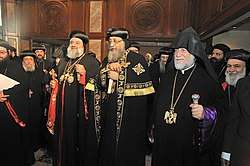
Liturgically speaking, the Church has much in common both with the Latin Rite in its externals, especially as it was at the time of separation, as well as with the Eastern Orthodox Church. For example, Armenian bishops wear mitres almost identical to those of Western bishops. They usually do not use a full iconostasis, but rather a sanctuary veil (a curtain usually with a cross or divine image in the center, used also by the Syriac Churches). The liturgical music is Armenian chant. Many of the Armenian churches also have pipe organs to accompany their chant.
Armenian priests below the rank of Very Reverend are allowed to be married before ordination and their descendants' surnames are prefixed with the prefix "Der" (or "Ter" in Eastern Armenian), meaning "Lord", to indicate their lineage. Such a married priest is known as a kahana.
The Armenian Apostolic Church celebrates the Nativity of Jesus in combination with the Feast of the Epiphany, putting Armenian Christmas on 6 January in the church's calendar. This contrasts with the more common celebration of Christmas on 25 December, originally a Western Christian tradition, which Armenia only briefly adopted before reverting to its original practice.[32]
Armenian Apostolic Church uses a version of the Bible based on the Greek translation (Septuagint) of the Hebrew Old Testament, which was produced in Egypt in the court of King Ptolemy II Philadelphus (283-246 BC), and includes Deuterocanonical books that are not a part of the present Hebrew and Protestant canons. There is plenty of evidence indicating that the Septuagint was the Old Testament version used throughout the early Christian Church and was revised in the course of the first and second centuries.[33]
Since 1923, the church has mainly used the Gregorian Calendar shared by most civil authorities and Western Christian churches (not the traditional Armenian calendar). The only exception is the Armenian Patriarchate of Jerusalem, where the old Julian calendar is used, putting Nativity celebrations on 19 January in the Gregorian calendar.[34]
The Armenian Apostolic Church is distinct from the Armenian Catholic Church, the latter being a sui juris Eastern Catholic Church, part of the Catholic Church. When in the 1740s, Abraham-Pierre I Ardzivian, who had earlier become a Catholic, was elected as the patriarch of Sis, he led part of the Armenian Apostolic Church into full communion with the Pope and the Armenian Catholic Church was created.
Women in the Armenian Church
The Armenian Church does not ordain women to the priesthood.[35] Historically, however, monastic women have been ordained as deacons within a convent environment.[36] Monastic women deacons generally do not minister in traditional parish churches or cathedrals, although the late Mother Hrip'seme did so minister and served during public liturgies, including in the United States.[37]
Women do serve as altar girls and lay readers, especially when a parish is so small that not enough boys or men are regularly available to serve.
Women commonly serve the church in the choir and at the organ, on parish councils, as volunteers for church events, fundraisers, and Sunday schools, as supporters through Women's Guilds, and as staff members in church offices.
In the case of a married priest (Der Hayr), the wife of the priest generally plays an active role in the parish and is addressed by the title Yeretzgin.
In limited circumstances, the Armenian Church allows for divorce and remarriage. Cases usually include either adultery or apostasy.
Armenian genocide victims canonization
On April 23, 2015, the Armenian Apostolic Church canonized all the victims of the Armenian Genocide; this service is believed to be the largest canonization service in history.[38][39][40] 1.5 million is the most frequently published number of victims, however, estimates vary from 700,000 to 1,800,000. It was the first canonization by the Armenian Apostolic Church in four hundred years.[41]
Current state
In Armenia
.jpg)
The status of the Armenian Apostolic Church within Armenia is defined in the country's constitution. Article 8.1 of the Constitution of Armenia states: "The Republic of Armenia recognizes the exclusive historical mission of the Armenian Apostolic Holy Church as a national church, in the spiritual life, development of the national culture and preservation of the national identity of the people of Armenia." Among others, ethnographer Hranush Kharatyan has questioned the constitutionality of the phrase "national church".[42]
In 2009, further constitutional amendments were drafted that would make it a crime for non-traditional religious groups to proselytize on adherents of the Apostolic Church. Minority groups would also be banned from spreading 'distrust' in other faiths.[43] These draft amendments were put on hold after strong criticism voiced by the Council of Europe and the Organization for Security and Cooperation in Europe. Armenian religious minorities and human rights groups also expressed serious concern over the amendments, with human rights activist Stepan Danielian stating "the Armenian Apostolic Church today wants to have a monopoly on religion". The Armenian Church defines religious groups operating outside its domain as "sects" and, in the words of spokesman Bishop Arshak Khachatrian, considers that "their activities in Armenia are nothing but a denial of the creed of the Armenian Apostolic Church, which is considered the national religion of the Armenian people". Hrant Bagratyan, former Prime Minister of Armenia, condemned the close association of the Armenian Apostolic Church with the Armenian government, calling the Church an "untouchable" organisation that is secretive of its income and expenditure.[44]
In Artsakh
After the Bolshevik revolution and the subsequent annexation of Armenia by the U.S.S.R., all functioning religious institutions in NKAO were closed down and clergymen often either exiled or shot.
After a while the Armenian Apostolic Church resumed its activities. There were weddings, baptisms, and every Sunday Church Liturgy at a free will attendance basis. The Armenian Apostolic Church since 1989 restored or constructed more than 30 churches worldwide. In 2009 the Republic of Artsakh government introduced a law entitled "Freedom of Conscience and Religious Organisations", article 8 of which provided that only the Armenian Apostolic Orthodox Church is allowed to preach on the territory of the Republic of Artsakh. However, the law did make processes available for other religious institutions to get approval from the government if they wished to worship within the Republic.[45]
Armenian diaspora
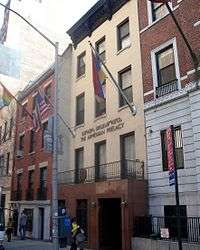
Outside of West Asia, today there are notable Armenian Apostolic congregations in various countries in Europe, North America, South America, and South Asia.
Lebanon, home to a large and influential Armenian diaspora community with its own political parties, has more than 17 recognized Armenian Apostolic churches. The Armenian presence in Palestine and Israel is primarily found in the Armenian Quarter of Jerusalem, under the jurisdiction of the Armenian Patriarchate of Jerusalem. Syria has one Armenian church, St Sarkis, in Damascus. There are a number of Armenian churches in Jordan including the St Thaddeus church in the Armenian quarter of Jabal Ashrafieh in Amman and the St Garabed church at the site of the baptism of Jesus Christ by the Jordan river
The Armenian Patriarchate of Constantinople in Turkey and the Armenian Apostolic Church of Iran are important communities in the diaspora. These churches represent the largest Christian ethnic minorities in these predominantly Muslim countries.
The United Kingdom has three Armenian churches: St Sarkis in Kensington, London; Saint Yeghiche in South Kensington, London; and Holy Trinity in Manchester.
Ethiopia has had an Armenian church since the 1920s, when groups of Armenians were invited there after the Armenian Holocaust by the Ottoman Empire.
Historical role and public image
The Armenian Apostolic Church is "seen by many as the custodian of Armenian national identity".[46] "Beyond its role as a religious institution, the Apostolic Church has traditionally been seen as the foundational core in the development of the Armenian national identity as God's uniquely chosen people."[47] According to a 2018 survey by the Pew Research Center, in Armenia 82% of respondents say it is very or somewhat important to be a Christian to be truly Armenian.[48]
According to a 2015 survey 79% of people in Armenia trust it, while 12% neither trust it nor distrust it, and 8% distrust the church.[49]
Controversies and criticisms
Medieval era
Early medieval opponents of the Armenian Church in Armenia included the Paulicians (7th-9th centuries) and the Tondrakians (9th-11th centuries).
The power relationship between catholicoi and secular rulers was sometimes a source of conflict. In 1037 king Hovhannes-Smbat of Ani deposed and imprisoned Catholicos Petros, who he suspected of holding pro-Byzantine views, and appointed a replacement catholicos. This persecution was highly criticized by the Armenian clergy, forcing Hovhannes-Smbat to release Petros and reinstall him to his former position. In 1038 a major ecclesiastical council was held in Ani, which denied the king the right to elect or remove a catholicos.[50]
Architecture historian Samvel Karapetyan has criticized many aspects of the Armenian Apostolic Church, especially its role in Armenian history. Karapetyan particularly denounces, what he calls, Armenian Church's loyal service to foreign invaders: "The Armenian Apostolic Church is a conscientious tax structure, which every conqueror needs."[51]
Modern era
| Surveys on public views of the church by the IRI | |||
| Date | Favorable | Unfavorable | No opinion |
|---|---|---|---|
| 2006[52] | 76% | 22% | 2% |
| 2007[53] | 81% | 17% | 2% |
| 2018[54] | 57% | 42% | 1% |
| 2019[55] | 71% | 23% | 6% |
In independent Armenia, the Armenian Apostolic Church has often been criticized for its perceived support of the governments of Robert Kocharyan and Serzh Sargsyan despite the formal separation of church and state in Armenia.[56][57][58][59][60] According to former Prime Minister Hrant Bagratyan religion and state management "have completely gotten mixed up". He called the church an "untouchable" organization that is secretive of its income and expenditure.[61] Large-scale construction of new churches in the independence period[62] and the negligence of endangered historic churches by the Apostolic church (and the government) have also been criticized.[63]
—Stepan Danielyan, scholar on religion, 2013[64]
In recent years, several high-profile leaders of the church have been involved in controversies.[63] In 2013 Navasard Ktchoyan, the Archbishop of the Araratian Diocese and Prime Minister Tigran Sargsyan were alleged to have been partners with a businessman charged with laundering US$10.7 million bank loan and then depositing most of it in accounts he controlled in Cyprus.[65] In 2011 it was revealed that Ktchoyan drives a Bentley (valued at $180,000-$280,000). Pointing out the 34% poverty rate in Armenia, Asbarez editor Ara Khachatourian called it "nothing but blasphemy". He added "Archbishop Kchoyan's reckless disregard and attitude is even more unacceptable due to his position in the Armenian Church."[66]
In October 2013 Father Asoghik Karapetyan, the director of the Museum of the Mother See of Holy Etchmiadzin, stated on television that an atheist Armenian is not a "true Armenian". A spokesperson for the Armenian Apostolic Church stated that it is his personal view.[67] The statement received considerable criticism,[68] though Asoghik did not retract his statement.[69] In an editorial in the liberal Aravot daily Aram Abrahamyan suggested that religious identity should not be equated with national (ethnic) identity and it is up to every individual to decide whether they are Armenian or not, regardless of religion.[70]
In 2016 Agos published a report about child abuse during the 90s at the Jarankavorats Armenian School in Jerusalem. According to the report several of the clergymen raped a young male student. This story first aired in a documentary aired on Israeli television.[71]
See also
- Armenian Catholic Church
- Armenian church architecture
- Armenian Patriarchate of Constantinople
- Armenian Patriarchate of Jerusalem
- Holy See of Cilicia
- Saint Narek chapel
Lists
- List of Catholicoi of Armenia
- List of Armenian Catholicoi of Cilicia
- List of Armenian Patriarchs of Constantinople
- List of Armenian Patriarchs of Jerusalem
Notes
References
Citations
- Armenian Apostolic Church (Mother See of Holy Etchmiadzin) and Armenian Apostolic Church (Holy See of Cilicia) in the World Council of Churches
- Panossian, Razmik (2006). The Armenians: From Kings and Priests to Merchants and Commissars. New York: Columbia University Press. pp. 43–44. ISBN 9780231139267.
The Armenian Apostolic Church formally became autocephalous—i.e. independent of external authority—in 554 by severing its links with the patriarchate of Constantinople.
- "Catholicos of All Armenians". armenianchurch.org. Mother See of Holy Etchmiadzin.
- ""ՀԱՅԱՍՏԱՆՅԱՅՑ ԱՌԱՔԵԼԱԿԱՆ ՍՈՒՐԲ ԵԿԵՂԵՑԻ" ԿԿ - HAYASTANYAYC ARAQELAKAN SURB YEKEGHECI RO". e-register.am. Electronic Register. Government of the Republic of Armenia.
- Augusti, Johann Christian Wilhelm; Rheinwald, Georg Friedrich Heinrich; Siegel, Carl Christian Friedrich. The Antiquities of the Christian Church. p. 466.
- Scott, Michael (2016-11-01). Ancient Worlds: A Global History of Antiquity. Basic Books. ISBN 978-0-465-09473-8.
- Grousset, René (1984) [1947]. Histoire de l'Arménie (in French). Payot. p. 122.. Estimated dates vary from 284 to 314. Garsoïan (op.cit. p. 82), following the research of Ananian, favours the latter.
- Gilman, Ian; Klimkeit, Hans-Joachim (2013-01-11). Christians in Asia before 1500. ISBN 9781136109782. Retrieved 5 March 2015.
- Jacob, P. H. (1895). A Brief Historical Sketch of the Holy Apostolic Church of Armenia. H. Liddell. Retrieved 5 March 2015.
- Issaverdenz, Jacques (1877). The Armenian Church. Retrieved 5 March 2015.
- Ehrman: Forgery and Counterforgery, pp455-458
- "The Aršakuni Dynasty (A.D. 12-[180?]-428)" by Nina Garsoïan, in Armenian People from Ancient to Modern Times, ed. R.G. Hovannisian, Palgrave Macmillan, 1997, Volume 1, p.81.
- Mary Boyce. Zoroastrians: Their Religious Beliefs and Practices Psychology Press, 2001 ISBN 0415239028 p 84
- Theo Maarten van Lint (2009). "The Formation of Armenian Identity in the First Millenium". Church History and Religious Culture. 89 (1/3): 269.
- See Drasxanakertci, History of Armenia, 78ff; Atiya, History of Eastern Christianity, 316ff; Narbey, A Catechism of Christian Instruction According to the Doctrine of the Armenian Church, 88ff.
- Drasxanakertci, History of Armenia, 86–87.
- Atiya, History of Eastern Christianity, 424-26.
- Narbey, A Catechism of Christian Instruction According to the Doctrine of the Armenian Church, 86–87.
- "Armenian Apostolic Church". Encyclopædia Britannica. Retrieved 5 March 2015.
- "Archived copy". Archived from the original on 2011-04-25. Retrieved 2010-02-11.CS1 maint: archived copy as title (link)
- "THE ISSUE BETWEEN MONOPHYSITISM AND DYOPHYSITISM". Nine Saints Ethiopian Orthodox Monastery. Archived from the original on 26 January 2011. Retrieved 28 January 2011.
- "Ecumenical Councils". Official website of the Mother See of Holy Etchmiadzin. Retrieved 28 January 2011.
- Harper, Douglas. "mono-". Online Etymology Dictionary.
- μόνος. Liddell, Henry George; Scott, Robert; A Greek–English Lexicon at the Perseus Project.
- μία in Liddell and Scott.
- "Catholicos of All Armenians Congratulated Newly Appointed Armenian Patriarch of Constantinople". Retrieved 5 January 2020.
- "St. Nersess Armenian Seminary". Retrieved 5 March 2015.
- "Documents 119-129. Bryce. Armenians. XV---Cicilia (Vilayet of Adan and Sankjak of Marash)". Retrieved 5 March 2015.
- Minassian, Oshagan (1974). "A History of the Armenian Holy Apostolic Orthodox Church in the United States". PhD Dissertation. ProQuest 288182086. Cite journal requires
|journal=(help) - Alexander, Ben (2007). "Contested Memories, Divided Diaspora: Armenian Americans, the Thousand-day Republic, and the Polarized Response to an Archbishop's Murder". Journal of American Ethnic History. 27 (1). Archived from the original on 2009-05-02.
- List of eparchies. Armenian Apostolic Church (Russia and New Nakhichevan eparchy).
- "Armenian Church". Archived from the original on 17 March 2011. Retrieved 5 March 2015.
- "FAQ -". Retrieved 2019-01-08.
- "Archived copy". Archived from the original on 2012-03-11. Retrieved 2014-10-13.CS1 maint: archived copy as title (link)
- "Ambitious International Women's Association". Archived from the original on 22 February 2012. Retrieved 5 March 2015.
- Oghlukian, Abel; Cowe, Peter (translator) (1994). The Deaconess in the Armenian Church. New York: St. Nersess Press. p. 59. ISBN 978-1-885011-00-8.
- Zagano, Phyllis (2008). "Catholic women's ordination: the ecumenical implications of women deacons in the Armenian Apostolic Church, the Orthodox Church of Greece, and the Union of Utrecht Old Catholic Churches". Journal of Ecumenical Studies. 43 (1): 124–137. ISSN 0022-0558.
- Davlashyan, Naira. "Armenian Church makes saints of 1.5 million genocide victims – Yahoo News". News.yahoo.com. Retrieved 2015-04-23.
- "Armenian Genocide victims canonized in Holy Etchmiadzin". Panarmenian.Net. Retrieved 2015-04-23.
- "Canonized: Armenian Church proclaims collective martyrdom of Genocide victims – Genocide". ArmeniaNow.com. Retrieved 2015-04-23.
- "After 400 years, new saints for the Armenian Church". Risu.org.ua. Retrieved 2015-04-23.
- "Կրոն և աղանդ. Հովհաննես Հովհաննիսյան, Հրանուշ Խառատյան" (in Armenian). Boon TV on YouTube. 7 February 2015.
- Tigran Avetisian, "U.S. Again Highlights `Restrictions' On Religious Freedom In Armenia" RFE/RL Armenia Report – 11/19/2010
- "No Separation of Church and State in Armenia?" epress.am article, 23-12-2010.
- Naira Hairumyan, "Karabakh: Will the new law on religion curb the number of sects in Karabakh?", ArmeniaNow, 24 April 2009.
- "Armenian Apostolic Church". Encyclopædia Britannica.
- Terzian, Shelley (2014). "Central effects of religious education in Armenia from Ancient Times to Post-Soviet Armenia". In Wolhuter, Charl; de Wet, Corene (eds.). International Comparative Perspectives on Religion and Education. AFRICAN SUN MeDIA. p. 28. ISBN 978-1-920382-37-7.
- "Eastern and Western Europeans Differ on Importance of Religion, Views of Minorities, and Key Social Issues". Pew Research Center. 29 October 2018.
- "Trust – Religious institutions respondent belongs to by Which religion or denomination, if any, do you consider yourself belong to? (%)". caucasusbarometer.org. Caucasus Barometer 2015 Armenia dataset.
- Edda Vartanyan (ed.), Horomos Monastery, Art and History, 2015, p. 241.
- "Դավանել հայ առաքելական եկեղեցի՝ նշանակում է փորել սեփական գերեզմանը". religions.am (in Armenian). 3 April 2014. Archived from the original on 2 November 2014.
- "Armenia National Voter Study: November 2006" (PDF). iri.org. Archived from the original (PDF) on 27 January 2020. Alt URL
- "Armenia National Study October 27 – November 3, 2007" (PDF). iri.org. Archived from the original (PDF) on 27 January 2020. Alt URL
- "Public Opinion Survey: Residents of Armenia: July 23–August 15, 2018" (PDF). iri.org. Archived from the original (PDF) on 26 October 2019.
- "Public Opinion Survey: Residents of Armenia: May 6-31, 2019" (PDF). iri.org. Archived from the original (PDF) on 9 July 2019.
- "Hovannisian Hits Back At Church Head As Thousands Again Rally In Yerevan". azatutyun.am. RFE/RL. 15 March 2013.
- "Եկեղեցին պետք է մտածի, քանի դեռ ուշ չէ. "Ժամանակ"". Aravot (in Armenian). 10 February 2015.
Իսկ հանրային կարծիքն այն է, որ ինչպես բիզնեսն ու իշխանությունները, այնպես էլ եկեղեցին և բիզնեսը սերտաճած են, և այս առումով եկեղեցական ղեկավարության բարքերը չեն տարբերվում հանրապետության ղեկավարության բարքերից:
- "Հայ առաքելական եկեղեցին դարձրել է իշխանությունների հաճոյակատարը և նրանց շեփորահարը.Սամվել Հովասափյան". Noyan Tapan (in Armenian). 5 January 2015.
- Jaloyan, Vardan (3 January 2015). "Եկեղեցին ընդդեմ հայոց պետականության". religions.am (in Armenian). Archived from the original on 27 February 2015.
- Khachatrian, Ruzanna (14 October 2004). "Opposition MP Slams Armenian Church For Backing Government". azatutyun.am. RFE/RL.
- "No Separation of Church and State in Armenia? Opinion". epress.am. 23 December 2010.
- Papyan, Siranuysh (10 February 2015). "Եկեղեցաշինության գումարներով կունենայինք ամենաարդիական զենքով զինված բանակ". lragir.am.
- Mekhitarian, V.; Kojayan, M.; Abrahamian, D. (13 August 2013). "Catholicos Karekin II Stands Accused". keghart.com.
- Karapetyan, Armen (7 October 2013). "Turbulent Times for Armenia's Ancient Church". Institute for War and Peace Reporting.
- Baghdasaryan, Edik; Aghalaryan, Kristine (31 January 2014). "Armenia: Church and State Deny Money Laundering". Organized Crime and Corruption Reporting Project.
- Khatchatourian, Ara (6 April 2011). "The Borgias of Etchmiadzin". Asbarez.
- "Աթեիստ հայը հայ չէ՞. Մայր Աթոռը չի ցանկանում մեկնաբանել Տեր Ասողիկի խոսքերը". news.am (in Armenian). 14 October 2013.
- Hunanyan, Samvel (1 November 2013). "Ցանկացած մարդ, ով իրեն հայ է համարում, նա հայ է, վերջացավ". Asparez (in Armenian).
- Hakobyan, Gohar (19 May 2014). "Տեր Ասողիկը հետ չի կանգնում իր խոսքերից. "Աթեիստ հայը լիարժեք հայ չէ"". Aravot (in Armenian).
- Abrahamyan, Aram (15 October 2013). "Բոլորը հայ են, ովքեր իրենց հայ են համարում". Aravot (in Armenian).
- "Child abuse everywhere". Agos. Retrieved 2018-11-25.
Sources
- Fahlbusch, Erwin (1999). "Armenian Apostolic Church". In Fahlbusch, Erwin (ed.). Encyclopedia of Christianity. 1. Grand Rapids: Wm. B. Eerdmans. pp. 127–128. ISBN 0802824137.
- Krikorian, Mesrob K. (2010). Christology of the Oriental Orthodox Churches: Christology in the Tradition of the Armenian Apostolic Church. Peter Lang. ISBN 9783631581216.CS1 maint: ref=harv (link)
Further reading
- Vrej Nerses Nersessian (2007). "Armenian Christianity" (PDF). In Parry, Ken (ed.). Blackwell Companion to Eastern Christianity. Malden, MA: Blackwell. pp. 23–46. Archived from the original (PDF) on 13 August 2011.
- Meyendorff, John (1989). Imperial unity and Christian divisions: The Church 450-680 A.D. The Church in history. 2. Crestwood, NY: St. Vladimir's Seminary Press. ISBN 9780881410556.CS1 maint: ref=harv (link)
- Ostrogorsky, George (1956). History of the Byzantine State. Oxford: Basil Blackwell.CS1 maint: ref=harv (link)
- Stopka, Krzysztof (2016). Armenia Christiana: Armenian Religious Identity and the Churches of Constantinople and Rome (4th-15th century). Kraków: Jagiellonian University Press. ISBN 9788323395553.CS1 maint: ref=harv (link)
Armenian religious relations with the Roman Catholic Church
- Pope Benedict XIV, Allatae Sunt (On the observance of Oriental Rites), Encyclical, 1755
- Common Declaration of Pope John Paul II and Catholicos Karekin I, 1996
- Common Declaration of John Paul II and Aram I Keshishian, 1997
- John Paul II to Karekin I, 1999
- Joint Declaration signed by John Paul II and Karekin II, 2000
- Greeting by Pope Benedict XVI to Catholicos Aram I, 2008
- Dialogue and Joint Declarations with the Roman Catholic Church
External links
| Wikimedia Commons has media related to Armenian Apostolic Church. |


